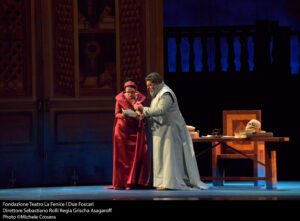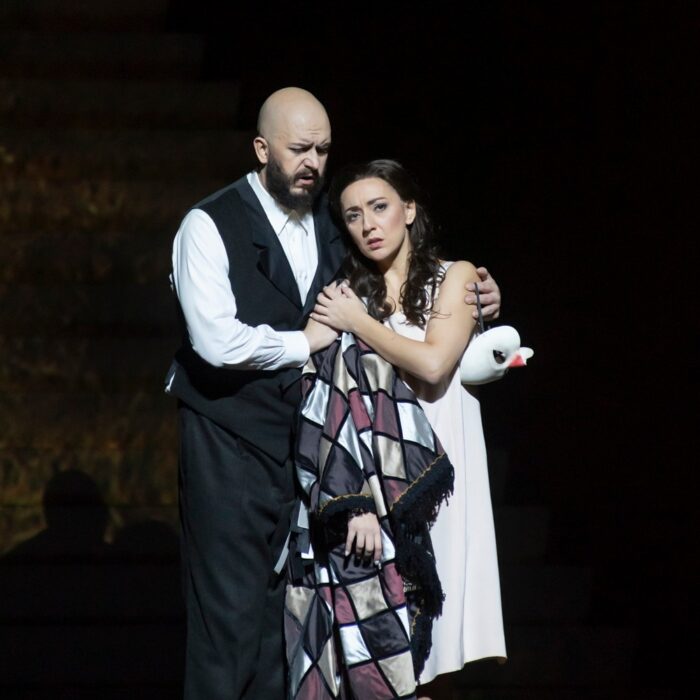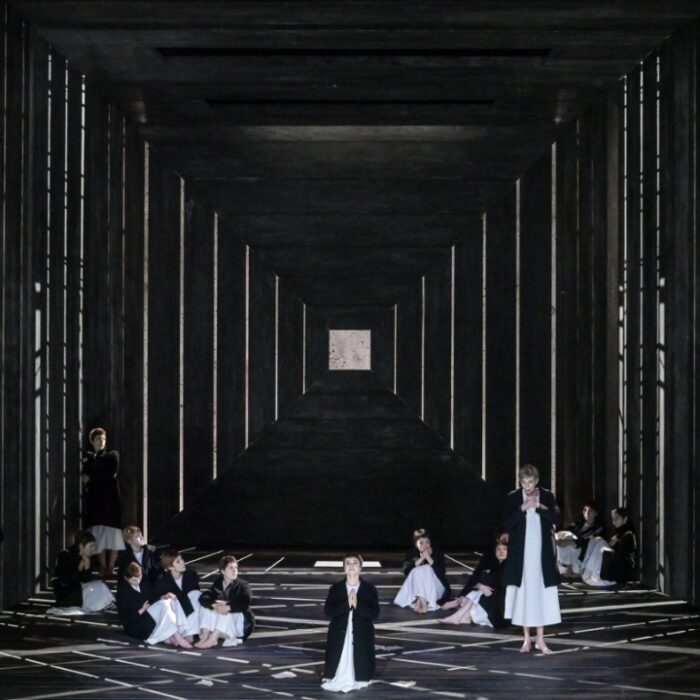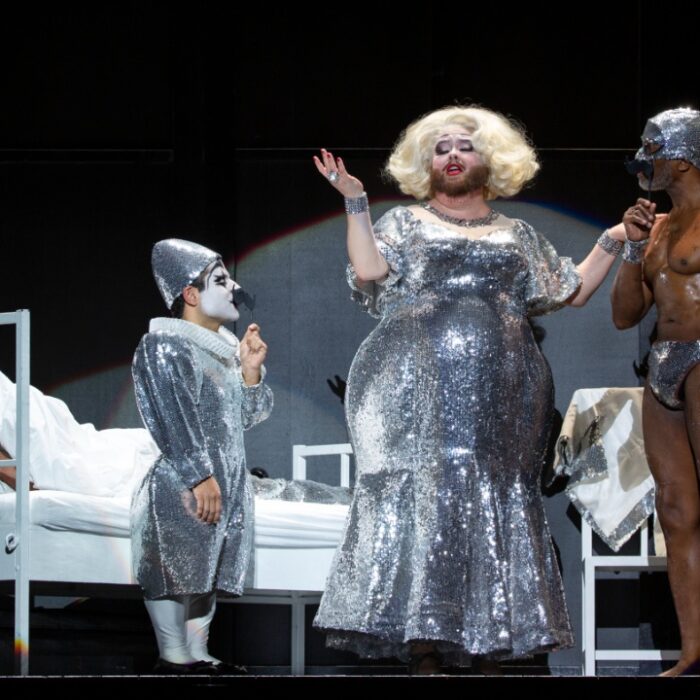
Teatro La Fenice 2022-23 Review: I Due Foscari
Salsi Leads Strong Cast With A Convincing Portrait Of Tragic Doge Foscari
By Alan Neilson(Credit: Michele Crosera)
After 1,100 years as an independent state, Napoleon’s invasion of Venice in 1797 brought the Venetian Republic to an end. Once the Queen of the Adriatic, with an empire extending throughout the Eastern Mediterranean, it has since been reduced to a small city in the north-east of Italy, with a declining population and overrun by tourists. Unfortunately, few know much about its history other than that it was famous for its carnival. To the more knowledgeable, however, the history of Venice is a fascinating tale of spies, warfare, doges, trade, splendid wealth, and a political system of byzantine complexity. Its famous Council of Ten is still able to send shivers down the spine. A walk through its narrow streets and wide piazzas, adorned with ornate palazzi and fabulous churches, brings Venice’s past thrillingly alive. Almost every building has a story to tell.
Above the gateway to the Doge’s Palace close to Piazza San Marco is a figure kneeling before the Lion of Saint Mark. It is a representation of Francesco Foscari, who was the longest-serving and arguably also its most famous doge, reigning between 1423 and 1457. Certainly, he was one of its more colorful and controversial. According to tradition, his predecessor warned against electing Foscari as doge, but this was ignored. The result of this was to precipitate a longstanding vendetta with his main rival, Pietro Loredan, and many of the city’s other patrician families. Unable to get to Foscari, they turned on his son, Jacopo, accusing him of murder and accepting bribes from foreign powers, for which he was tortured and eventually exiled to Crete for life, where he died. Soon after, Foscari was forced out of office and was dead within a week. Unsurprisingly, rumors about the real cause of his death circulated wildly.
Fast forward to Rome in 1844, and we find Verdi’s latest opera “I Due Foscari” being premiered at the city’s Teatro Argentina and not in Venice, as one might have expected. In fact, it did not reach Venice until 1847, where the authorities were uncomfortable with the opera’s negative impressions of the city and nervous about inflaming old enmities among its leading families, which is indicative of how close Piave’s libretto is to the actual events.
For La Fenice’s latest presentation of “I Due Foscari,” the theatre brought together a stellar cast under the guidance of stage director Grischa Asagaroff and musical director Sebastiano Rolli.
A Simple Yet Engaging Staging
Asagaroff devised a largely traditional production. The costumes, designed by Luigi Perego, were suggestive of the period; the councilors wore robes of red and black, the women wore long gowns of a single color, and the doge was attired in various robes of distinction with, of course, his corno ducale, when appropriate. Soldiers, the populace, and others were all dressed to fit into the staging, so they did nothing to disrupt the effect. However, there were a couple of conceits. During the barcarola at the beginning of Act three, the councilors paraded around the piazza in headwear modeled on the metal decoration at the front of a gondola and, surprisingly, they looked completely appropriate.
The staging, also designed by Perego, was dominated by a large cubical structure in the center of the stage that rotated to depict a different image on each of its faces. The most significant was that of Francesco Foscai’s tomb, which can actually be found in the Basilica S. Maria Gloriosa dei Frari. It is a splendid gothic construction that combines the personal with his position as doge, the two elements in the opera that are thrown into deadly conflict. Behind the cubic structure was a raised walkway, from which stairs on either side allowed the cast to walk down to the stage floor. It proved to be very adaptable, which Valerio Tiberi’s lighting designs enhanced through strong, distinct alterations in color.
Verdi himself, reflecting on the opera, admitted that “I Due Foscari” suffers somewhat from being too gloomy in its general tone. This, however, was not apparent in this production. For sure, there were many dark scenes in which the air of despair and vengeance was in the air, but Asagaroff offset their effect by making the most of local color, and his treatment of the barcarola scene was imaginatively and beautifully presented. Rather than just a chorus, he turned over the center of the stage to dancers in colorful costumes, which blew the gloom right out of the theatre. It created a strong contrast to what went before and to the grim ending that followed, in which both Francesco and Jacopo meet their ends, and gave the work a more balanced structure that enhanced the dramatic impact of the conclusion.
Asagaroff’s direction also ensured that the intimate, emotionally fraught interactions between the principal characters were dramatically convincing and that the chorus was involved in plenty of meaningful movement, enabling the drama to move forward at a pleasing pace. He clearly highlighted the desperation felt by Francesco, Jacopo and his wife, Lucrezia Contarini, and successfully captured the underlying sinister atmosphere and machinations that underscore the work. It was a neat and tidy presentation that successfully brought the drama to life in a clear, uncluttered fashion. There was no attempt to uncover hidden motivation, reveal secondary themes, or impose an obtuse reading on the work. And it worked splendidly!
Outstanding Performance From Salsi As The Doge
Francesco Foscari is the center of the opera, around which the drama plays out. He is trapped by his position as the doge from helping his son, and the psychological ramifications have to be convincingly played out by the baritone playing the role for the opera to work. Fortunately, Luca Salsi was more than up to the task. His nuanced characterization, in which he both looked and sounded the part, superbly captured the depth of his frustrations and pain and the love he has for his son and his daughter-in-law, Lucrezia. Throughout the opera, the pressures build upon the doge, and in a series of scena he gives voice to his turbulent emotions before exploding in the final part of Act three. In the aria “Egli ora parte…” in which he responds to the news of Jacopo’s exile, he expertly gave voice to his pain with an intense and deep reading. This was followed shortly by the aria “Questa dunque è l’iniqua mercede,” in which, having discovered that his son is now dead, he is confronted by the councilors, demanding he step down as the doge. Salsi’s produced a bravura performance of the highest quality in which he appeared to be living the emotions; each line was sensitively crafted with subtle and not so subtle dynamic and colorful infections, coated by his intense feelings of suffering, bitterness, and loss, for which he rightly received sustained applause.
Unfortunately, tenor Francesco Meli was less impressive in the role of his son, Jacopo Foscari. From his opening number, the arioso “Brezza del suol natio,” there was a noticeable heavy vibrato in his singing that worsened as he pushed into the upper register, which itself often sounded thin and less than pleasant. More significantly, although he sang with plenty of strength and passion, his vocal characterization verged on the clichéd. Rather than producing a bespoke reading that responded to the text and the onstage atmosphere, he went for an off-the-peg version, with the result that his portrayal was, at times, somewhat superficial. There were, however, some better moments: for example, the aria “All’infelice veglio” allowed him to show off his attractive middle register and well-moulded phrasing to good effect, which despite the intrusive heavy vibrato, was pleasing on the ear.
Soprano Anastasia Bartoli, essaying the role of Lucrezia Contarini, put in a first-rate performance, whom she characterized as courageous, determined, and emotionally strong. She possesses a wonderfully secure voice that is able to hold the line perfectly and transition between registers seamlessly. It is also a resonant, versatile voice in which she can inject plenty of color, and her coloratura is impressive. Moreover, her singing has a natural lyricism, enabling her to hold the melody with apparent ease. Her opening scene, in which she sings the cavatina “Tu al cui sguardo onnipossente,” followed by the cabaletta “Che mi rechi,” showed off all her qualities to brilliant effect. The cavatina allowed her to display her gentle coloratura, detailed phrasing, and ability to spin out long, delicate lines, while in the cabaletta she took the opportunity to demonstrate her excellent technique: on hearing that Jacopo has been given a sentence of exile, she unleashed an emotionally explosive reading in which she pushed the voice powerfully upwards, danced lightly across the line, took in leaps and infused the voice with emotional coloring.
As the vengeful Jacopo Loredano, bass Riccardo Fassi cut a convincing figure. Not only did he have a sinister presence, but his facial expressions and physical gestures made his hatred for and desire to bring about the fall of the Foscaris clear, which he backed up with a fine vocal performance. His voice possesses a dark tone with a natural authority, which he characterized successfully by enveloping it with a menacing veneer.
The three minor roles of Pisana, Barbarigo, and the Doge’s Servant were given strong presentations by mezzo-soprano Carlotta Vichi, tenor Marcello Nardis, and bass Enzo Borghetti.
The Coro del Teatro La Fenice, under the guidance of the Maestro del Coro Alfonso Caiani, sang spiritedly, clearly, and with dramatic force and acted out its parts convincingly.
The conductor, Sebastiano Rolli, elicited a dramatically nuanced reading, full of contrasts, from the Orchestra del Teatro La Fenice. Changes in pace, dynamics, and textural quality were all expertly managed. On occasions, there was a delicacy and sensitivity in which the textures were beautifully layered, allowing individual instruments to shine and to support the characters’ reflective thoughts. More often, the orchestra would be allowed to surge energetically forward with denser textures to capture the emotionally heated onstage exchanges. And the barcarola was beautifully forged to capture the spirit of the dance, which allowed for a fresher and brighter section.
Overall, it was a wonderful production. Rarely does one find a traditional reading, set, more or less, in its original period, that can hold attention so well while simultaneously capturing the opera’s dramatic depth and thrust so successfully. This, of course, was not only down to Asagaoff’s excellent staging, but also down to the splendid musical direction of Rolli and the wonderful performance of Salsi as Francesco Foscari.



